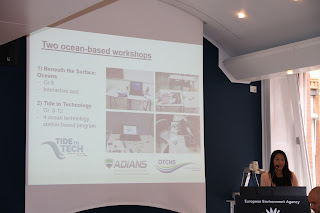TransAtlantic Ocean Literacy 2015 - Copenhagen
The Copenhagen workshop on TransAtlantic Ocean Literacy (TOL) took place September 25-25. It was organized by the Technical University of Denmark, National Institute of Aquatic Resources (DTU-Aqua), and hosted by the European Environment Agency (EEA).
 |
| European Environment Agency. Photo credit: Diana Payne |
This workshop builds on previous TOL efforts, but with a more specific focus. The overarching goal was to draft recommendations on how Ocean Literacy can serve marine research projects for greater societal impact, and contribute to Blue Growth objectives through more effective knowledge exchange and engagement with non-academic stakeholders and the public.
TOL Meeting Structure
The first day of the meeting consisted of four distinct 90 minute sessions with 3-4 presenters per session in a flash presentation format (5 slides/10 minutes max.) on relevant approaches to the session topic. Presentations were followed by group brainstorming to digest the strategic relevance of new terms/concepts and build capacity in the TOL community to provide a service to large research consortia.
 |
| Day 1 of the Copenhagen TOL meeting. Photo credit: Diana Payne |
Day 1: An Overview of Relevant Topics
The four sessions on Day 1 provided an overview of the relevance of Ocean Literacy to Blue Growth, Ocean Literacy as a skill for graduate students, the development of the Blue Schools network, and recent Ocean Literacy initiatives in Europe.Session 1 included experts from the US and Europe provided the context for TOL 2015:
 |
| Ivan Conesa Alcolea of the European Commission, DG Research & Innovation, Marine Resources, discusses Ocean Literacy in the context of Blue Growth. Photo credit: Diana Payne |
 |
| Paula Keener, Director of NOAA's Office of Ocean Exploration and Research, provides the NOAA perspective. Photo credit: Diana Payne |
Ivo Grigorov helps participants make the connection between the TOL vision and the relation to Blue Growth and societal impact. A key concept of the workshop is working with ocean science researchers to apply ocean literacy outreach towards greater and more measurable societal impact.
 |
| Co-convener Ivo Grigorov provides the 2015 TOL workshop overview . Photo credit: Diana Payne |
 |
| Peter Tuddenham and Tina Bishop sorted participant comments from Session 1 into relevant themes. Photo credit: Diana Payne |
Sessions 2, 3 and 4 provided an overview of approaches and initiatives relevant to the workshop goal. Session 2 focused on demonstrating the value of outreach skills for career development and research excellence for ocean scientists. Presentations included an overview of the NSF Broader Impacts criterion, the COSEE Scientist study, and Communicating Ocean Sciences course.
My presentation in Session 2 focused on the Ocean Science and Technology Day (OSTD) example from COSEE-TEK. I provided an overview of the program and the evaluation results compiled from three years of data. I also discussed the OSTD in the context of the COSEE Scientist study, which was presented via video by Dr. Rena Dorph.
 |
| Discussing the link between outreach and developing societally relevant research questions. Photo credit: Ivo Grigorov |
The third session examined the Blue Schools concept as proposed by the EU-funded SeaChange project with European, US and Canadian perspectives.
 |
| Sonya Lee shares the work of the Discovery Center. Photo credit: Diana Payne |
The final session showcased the European projects SeaChange, ResponSEAble and Sea Changers to highlight potential synergies among TOL partner initiatives.
 |
| The EU SeaChange project. Photo credit: Diana Payne |
No comments:
Post a Comment
Note: Only a member of this blog may post a comment.